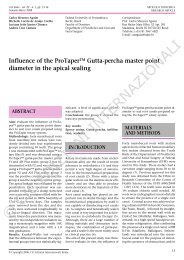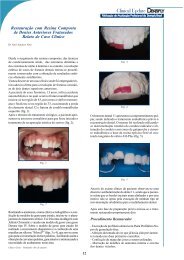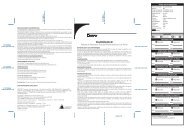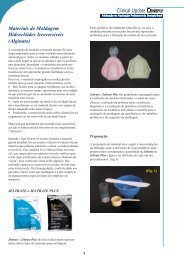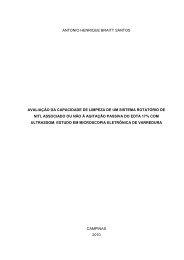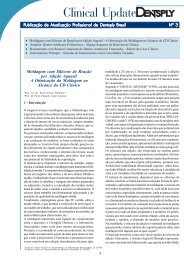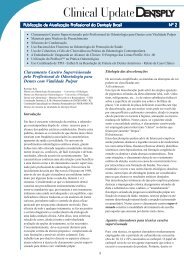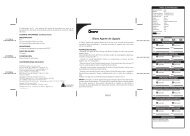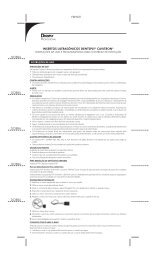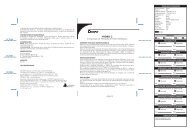You also want an ePaper? Increase the reach of your titles
YUMPU automatically turns print PDFs into web optimized ePapers that Google loves.
Raffaelli et al<br />
Table 1 Groups of materials and techniques<br />
Groups Adhesive Activator Adhesive Cement Ceramic disk<br />
thickness (mm)<br />
1 Prime & Bond NT no LC DC 3<br />
2 XP BOND no LC DC 3<br />
3 XP BOND yes NC DC 2<br />
4 XP BOND yes NC DC 3<br />
5 XP BOND yes NC DC 4<br />
6 XP BOND yes NC CC 2<br />
7 Syntac* - NC CC 2<br />
NC: not cured (mix with SCA is applied, but not light cured); LC: light cured (light cured before placement); DC: dual curing (Light is applied on the mixed<br />
cement); CC: chemically cured (no light is used at all). *According to the directions for use, application and light curing of Heliobond is mandatory when combined<br />
with self curing materials.<br />
MATERIALS AND METHODS<br />
Bonding was performed on 70 noncarious human third molars<br />
that were extracted after informed consent had been obtained.<br />
They were stored in a 1% chloramine T solution at<br />
4°C and used within one month following extraction. Prior to<br />
the bonding experiments, the teeth were retrieved from the<br />
disinfectant solution and stored in distilled water, with four<br />
changes of the latter within 48 h to remove the disinfectant.<br />
Tooth Preparation – Bonding to Deep Dentin<br />
Bonding was performed on the occlusal surfaces of deep<br />
coronal dentin. The occlusal enamel and the superficial<br />
dentin of each tooth were removed using a slow-speed saw<br />
(Isomet, Buehler; Lake Bluff, IL, USA) under water cooling.<br />
The tooth surfaces were polished with wet 180-grit SiC papers.<br />
The teeth were divided into 7 experimental groups of<br />
10 teeth each. The experimental dentin groups are listed in<br />
Table 1.<br />
Coupling of Processed Ceramic<br />
Empress 2 blocks (shade A2) were reduced with the Isomet<br />
saw under water cooling to produce blocks with dimensions<br />
similar to those of the teeth to be bonded. Each reduced<br />
block was then sectioned with the Isomet saw to produce<br />
2-, 3-, or 4-mm-thick, parallel-sided ceramic onlays. The inner<br />
surface of each ceramic onlay was sandblasted with 50-<br />
μm alumina, etched with a hydrofluoric acid gel for 90 s,<br />
washed, air dried, and silanized using Calibra silane<br />
(<strong>Dentsply</strong>).<br />
To bond the ceramic disks to the dentin surface, the<br />
bonding systems and the resin cement were used following<br />
manufacturer’s instructions. As a curing device, a QTH light<br />
(<strong>Dentsply</strong> DeTrey) was used (power output: 800 mW/cm 2 ).<br />
The intensity of the curing light was tested before and after<br />
curing with a radiometer. The bonded specimens were<br />
stored in distilled water at 37°C for 24 h before further laboratory<br />
processing.<br />
TBS Evaluation and SEM Fractographic Analysis<br />
Each tooth was sectioned occluso-gingivally into serial slabs<br />
using an Isomet saw under water cooling. The two slabs from<br />
each tooth were further sectioned into 0.9 x 0.9 mm ceramic-dentin<br />
beams, according to the technique for the<br />
nontrimming version of the microtensile test. 6 Each group<br />
provided 37 to 53 beams for bond strength evaluation. Premature<br />
failures that occurred during sectioning were recorded.<br />
The specimens were stressed to failure under tension using<br />
a universal testing machine (Model 4440, Instron; Canton,<br />
MA, USA) at a crosshead speed of 1 mm/min. The data<br />
were analyzed using one-way ANOVA and Tukey’s multiple<br />
comparison tests at α = 0.05.<br />
Representative fractured beams from each of the 7<br />
groups were air dried and sputter coated with gold/palladium<br />
for examination with a conventional SEM (Jeol; Tokyo,<br />
Japan).<br />
Statistical Analysis<br />
Three different one-way ANOVAs were performed, each involving<br />
different groups (Tables 2 to 4). The first two analyses<br />
were performed in the groups with 3-mm and 2-mm ceramic<br />
disks, respectively. The last analysis was performed<br />
on groups with 3 different ceramic thicknesses (2, 3, and 4<br />
mm) when samples were luted with XP+SCA+Calibra DC.<br />
Premature failures were excluded from the statistical analysis.<br />
It was also verified that the tooth of origin was not a significant<br />
factor for bond strength.<br />
As the bond strength data were normally distributed (Kolmogorov-Smirnov<br />
test) and groups had homogeneous variances<br />
(Levene test), one-way ANOVA was applied to test for<br />
significance of differences among the tested groups, followed<br />
by Tukey’s test for post-hoc comparisons. In all the<br />
analyses, the level of significance was set at α = 95%.<br />
RESULTS<br />
The bond strength values found in this investigation are reported<br />
in Fig 1 and Tables 2 to 4.<br />
276 The Journal of Adhesive Dentistry



